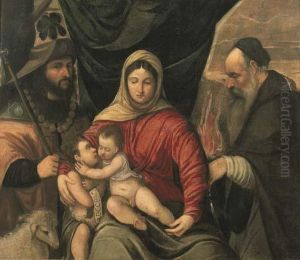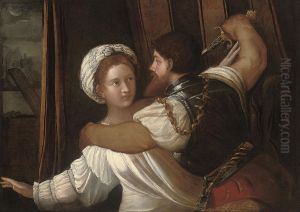Bernardino Da Asola Paintings
Bernardino da Asola was an Italian Renaissance painter, whose career spanned the early part of the 16th century, a period known for its significant developments in art and intellectual life in Italy. Born in 1490, Bernardino was part of an era that witnessed the flourishing of High Renaissance art, a time when artists were engaging in a deeper exploration of perspective, human anatomy, and classical themes, pushing the boundaries of artistic expression and technique.
While Bernardino da Asola may not be as widely recognized as contemporaries such as Leonardo da Vinci, Michelangelo, or Raphael, his contributions to the art world, particularly in the Veneto region of Italy, were noteworthy. His works were characterized by their delicate attention to detail, vibrant color palettes, and the serene religiosity that permeated much of Renaissance art. Bernardino's thematic focus often revolved around religious scenes and portraits, a common practice among artists of his time who were largely commissioned by the Church and devout patrons.
During his career, Bernardino da Asola was influenced by the luminaries of his time, absorbing the stylistic nuances and innovations that were sweeping through Italy. However, specific details about his training and the artists under whom he may have apprenticed remain scarce, leaving a gap in the comprehensive understanding of his artistic development. Despite this, his surviving works suggest a mastery of the techniques that defined the Renaissance, demonstrating his ability to convey depth, emotion, and spiritual fervor through his paintings.
Bernardino's contributions extend beyond his individual works, as he was part of the broader narrative of the Renaissance movement that laid the foundation for future generations of artists. His life and career were cut short when he died in 1530, but the legacy of his art continues to be appreciated for its role in the rich tapestry of Renaissance art history. Bernardino da Asola's work remains a testament to the vibrant cultural and artistic milieu of 16th-century Italy, embodying the spirit of an age that continues to captivate the imagination of art lovers and historians alike.

